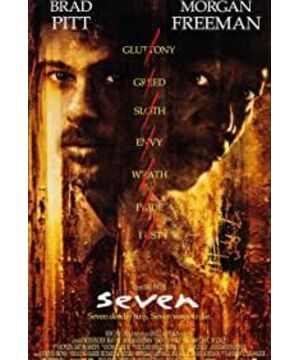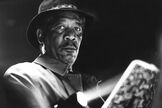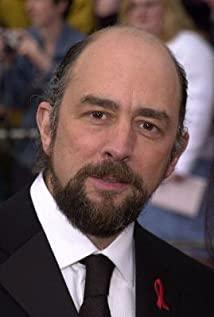I have seen the movie "Seven Deadly Sins" twice. The first time I saw it, I was curious and wanted to see how the person corresponding to each sin died. The second time you watch, keep an eye out for things other than the plot.
I found that not every sin is given the same role. According to the order of appearance - gluttony: detailed; greed: detailed; laziness: detailed; pride: little; lust: little; jealousy and anger: detailed, climax.
At first glance, I thought that the director was sloppy and didn't handle every case well, but looking at it again, I probably understood why.
Gluttony: Details. This is the first case, and in the progression of the story, it is the first time two detectives meet. At this time, neither the detective nor the audience knew what was going on, but such a terrifying scene immediately lifted people's spirits. To start, it must be disgusting and scary enough. The director handles the scene of the first case in detail, down to the fact that a vomit bucket is placed under the table, which makes people nauseous, but also adds credibility.
Greed: slightly. The second case scene is very ordinary, the appearance of the lawyer is so ordinary that the audience will probably forget it after seeing it. His death was not even terrifying. The biggest effect of this case is the upside-down painting. The murderer deliberately arranged for the police to find out, so he found the third victim. Here's a small episode hidden: a reporter broke into the scene of the case and filmed Detective Mills. The episode was inconsequential while watching it, but later found out that the pretend reporter was the murderer. The audience couldn't help gasping for breath at the murderer's wisdom. The biggest role of the second case is to provide clues to the main line and branch lines, suggesting the ending.
Laziness: Details. I guess no one will forget the appearance of a mummified victim. The audience calmed down a bit in the second case, then immediately horrified. From the appearance of the mummy when the sheet was uncovered (the audience thought he was dead), to the mummy's sudden inhalation, and then to the hand that was cut off and soaked in formalin later found at the murderer's house, the audience's emotions been mobilized. In addition to creating a terrifying atmosphere, the police detectives (and the audience) must take the murderer seriously at this time, because this is clearly a murder case for preaching, how can the murderer be stopped before the next case occurs? Who is the murderer? His motive?
Pride: slightly. The audience only saw pictures of so-called beautiful women hanging on the wall, and only a few shots of dead bodies on the bed.
Lust: slightly. Similarly, except for the photos, the prostitute did not appear, but the frightened client told what happened.
These two cases happened after the lazy case, after the detective found the murderer's nest and pursued it fiercely to no avail. Usually homicide movies, the murderer is found at the end, and this movie finds the murderer after the third case, which seems a little unusual. The discovery of the murderer, however, cannot prevent the increase of cases, and also increases the unease of the police detectives (audience). Does it follow the sin, one case after another, until the end? But if so, is it too linear? This is a cessation, heralding the arrival of the final climax. In order to push the climax to the audience, the two cases before the climax are purely story explanations and do not need to be embellished with thick ink. Although omitting the narrative does not stimulate the audience's eye, it can highlight the main point.
Jealousy and Anger: Details. In the climax part, because it is a climax, the director must do everything possible to catch the audience by surprise. The detective (the audience), after going through five cases, is already at a loss as to how things are going. Everyone was stunned when they saw the murderer walk into the police station and surrender himself. Everyone felt that things were not that simple, and what happened to the remaining two murders. The director slowed down the rhythm (suspension), the car drove slowly towards the wilderness, and the three people in the car had a conversation. The seemingly quiet atmosphere made people even more nervous, but they had to listen to the murderer seriously say his "idea". This is the first time the police detective (audience) has communicated face-to-face with the murderer about the outlook on life and the world. The murderer said it calmly, but the grumpy Mills was scolding the mother. The audience can't help but agree with what the murderer said in their hearts, the cold talk of people in daily life, and the indifference to sin. The method used by the director is actually very similar to the unreliable narrator used in Nabokov's "Lolita" - the audience/reader knows that the narrator is unreliable and their actions are wrong, but they cannot simply hate Or condemnation, there will even be understanding and recognition in the heart. Even if the smart audience can't guess the ending, they probably know that the final tragedy is related to Mills. Mills doesn't know what's going to happen, and the audience can't help shaking their heads: poor man, you're still talktalktalk, you don't know tragedy awaits you. Everything confirms the idea of the murderer, and people ignore everything around them: people cannot stop the injustice caused by lawyers (the lawyers who were killed and the lawyers hired by the murderer); Said that for the sake of life, he didn't want to but couldn't; the old police detective drove through the riotous street, glanced at it, and continued to drive away; the police detective Mills was determined to come to the new city to work, and his wife was lonely and pregnant; Homicide interest and curiosity disappear after three months and so on. People in society are selfishly disregarded, but they will be punished for it.
The movie reminds me of the "Subway Sarin Incident" mentioned by Haruki Murakami. The motive of Aum Shinrikyo is to sayno to the numb and mechanized society. They pursue differentiation, which Murakami calls "differences with nowhere to go". It is not the crimes against humanity initiated by a few naturally evil people, but the result of the society we endure silently and live in. And because society is a collection of people, it is we who have created the evil that destroys ourselves. How many times in our life have we seen injustice, instead of standing up, we just meditated "there's no way, this is the reality"?
The reason why people ignore it, will be helpless, will be unhappy, but continue to endure because everyone is like this, is because some "incidents" are not triggering on themselves. If a person is like Mills in that situation, he will find that sin has never disappeared, and he has always been a sinner.
The director uses a detailed and staggered approach to introduce the audience into a moral dilemma that varies from person to person, but is not black and white. That's why this movie is so interesting and makes me watch it again and again.
View more about Se7en reviews











